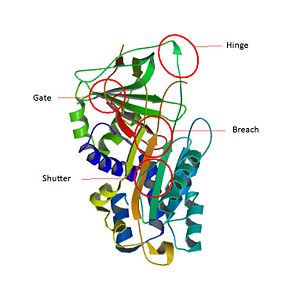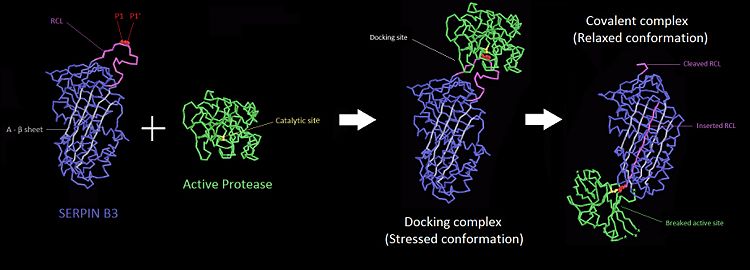Sandbox Reserved 954
From Proteopedia
(Difference between revisions)
| (7 intermediate revisions not shown.) | |||
| Line 9: | Line 9: | ||
Serpins are a superfamily of proteins wich are functionally distinct but structurally conserved. <ref>JBC Papers in Press. Published on July 2, 2001 as Manuscript R100016200 THE SERPINS ARE AN EXPANDING SUPERFAMILY OF | Serpins are a superfamily of proteins wich are functionally distinct but structurally conserved. <ref>JBC Papers in Press. Published on July 2, 2001 as Manuscript R100016200 THE SERPINS ARE AN EXPANDING SUPERFAMILY OF | ||
| - | STRUCTURALLY SIMILAR BUT FUNCTIONALLY DIVERSE | + | STRUCTURALLY SIMILAR BUT FUNCTIONALLY DIVERSE PROTEINS, http://www.jbc.org/content/early/2001/07/02/jbc.R100016200.full.pdf DOI : 2001/07/02/jbc.R100016200.full.pdf </ref> |
SerpinB3 means serin protease inhibitor, clade B (for ovalbumin), member 3. The particularity of serpin B3 is to target proteases which have a nucleophilic cysteine instead of serine in their catalytic site. | SerpinB3 means serin protease inhibitor, clade B (for ovalbumin), member 3. The particularity of serpin B3 is to target proteases which have a nucleophilic cysteine instead of serine in their catalytic site. | ||
SCCA1 is a <scene name='60/604473/Trimeric/1'>trimeric protein</scene><ref> PMID : 19166818 </ref>. <scene name='60/604473/One_subunit/1'>One subunit</scene> has three β sheets termed <scene name='60/604473/A_beta_sheet/3'>A (7 stranded)</scene>, <scene name='60/604473/B_beta_sheet/2'>B (5 stranded)</scene> and <scene name='60/604473/C_beta_sheet/2'>C (6 stranded)</scene> and <scene name='60/604473/Alpha_helices/1'>11 α helices (hA to hK)</scene> <ref>Gary A. Silverman1*, Phillip I. Bird2 | SCCA1 is a <scene name='60/604473/Trimeric/1'>trimeric protein</scene><ref> PMID : 19166818 </ref>. <scene name='60/604473/One_subunit/1'>One subunit</scene> has three β sheets termed <scene name='60/604473/A_beta_sheet/3'>A (7 stranded)</scene>, <scene name='60/604473/B_beta_sheet/2'>B (5 stranded)</scene> and <scene name='60/604473/C_beta_sheet/2'>C (6 stranded)</scene> and <scene name='60/604473/Alpha_helices/1'>11 α helices (hA to hK)</scene> <ref>Gary A. Silverman1*, Phillip I. Bird2 | ||
| Line 30: | Line 30: | ||
===Conformational changes of serpins=== | ===Conformational changes of serpins=== | ||
| - | The inhibitory members of serpin family undergo an unusual conformational change, the Stressed to Relaxed transition. This structural transition causes the <scene name='60/604473/The_rcl_loop_scene/3'>RCL</scene> insertion into <scene name='60/604473/A_beta_sheet/3'>A β-sheet</scene> thereby the <scene name='60/604473/The_rcl_loop_scene/3'>RCL</scene> forms an extra β strand. The serpin conformational change is essential for the inhibitor mechanism of proteases. <scene name='60/604473/Rcl_insertion_into_beta_sheet/1'>Some amino-acids of RCL</scene> wich belong to a consensus sequence for inhibitory serpins are thought to permit the insertion of the <scene name='60/604473/The_rcl_loop_scene/3'>RCL</scene> into the <scene name='60/604473/A_beta_sheet/3'>A β-sheet</scene>.<ref> James C Whisstocka, 2, Richard Skinnera, 2, Robin W Carrella, Arthur M Leska, Conformational changes in serpins: I. the native and cleaved conformations of α1-antitrypsin1, http://www.sciencedirect.com/science/article/pii/S0022283699935209 DOI: | + | The inhibitory members of serpin family undergo an unusual conformational change, the Stressed to Relaxed transition. This structural transition causes the <scene name='60/604473/The_rcl_loop_scene/3'>RCL</scene> insertion into <scene name='60/604473/A_beta_sheet/3'>A β-sheet</scene> thereby the <scene name='60/604473/The_rcl_loop_scene/3'>RCL</scene> forms an extra β strand. The serpin conformational change is essential for the inhibitor mechanism of proteases. <scene name='60/604473/Rcl_insertion_into_beta_sheet/1'>Some amino-acids of RCL</scene> wich belong to a consensus sequence for inhibitory serpins are thought to permit the insertion of the <scene name='60/604473/The_rcl_loop_scene/3'>RCL</scene> into the <scene name='60/604473/A_beta_sheet/3'>A β-sheet</scene>.<ref> James C Whisstocka, 2, Richard Skinnera, 2, Robin W Carrella, Arthur M Leska, Conformational changes in serpins: I. the native and cleaved conformations of α1-antitrypsin1, http://www.sciencedirect.com/science/article/pii/S0022283699935209 DOI:10.1006/jmbi.1999.3520</ref>Key regions able to control and modulate the conformational change of RCL. The hinge which is the <scene name='60/604473/P9-p15/1'>P15-P9 portion of the RCL</scene> is responsible for the mobility which is essential during the conformational change in the Stress to Relax transition. The breach is situated in the top of the <scene name='60/604473/A_beta_sheet/3'>β-sheet</scene>. It is located at the point of initial insertion of the <scene name='60/604473/The_rcl_loop_scene/3'>RCL</scene> into the <scene name='60/604473/A_beta_sheet/3'>A β-sheet</scene>. The shutter is next to the <scene name='60/604473/A_beta_sheet/3'>A β-sheet</scene>. It facilitates the beta-sheet opening and accept the conserved hinge of the <scene name='60/604473/The_rcl_loop_scene/3'>RCL</scene> as it insert. The gate is fully inserted into the <scene name='60/604473/A_beta_sheet/3'>A β-sheet</scene> without cleavage, the <scene name='60/604473/The_rcl_loop_scene/3'>RCL</scene> has to pass around the β-turn linking strands. |
| - | [[Image:Structure region.jpg|center|thumbnail|300px|'''Key regions able to control and modulate the conformational change of RCL''']] | + | |
| + | [[Image:Structure region.jpg|center|thumbnail|300px|'''Key regions able to control and modulate the conformational change of RCL<ref>PMID :11116082</ref>''']] | ||
==Main SCCA1 function== | ==Main SCCA1 function== | ||
| Line 68: | Line 69: | ||
Tumor markers are compounds present in abnormal concentration in serum or urine in patients who develop a malignant tumor. Nevertheless tumor markers can appear in people who do not suffer from cancer or at low concentration in sick patients, this is called the false negative or false positive. Tumor markers are used to detect, prevent, diagnose, predict, determine, prognostic and therapeutic monitoring. Tumor markers need to be specific and sensitive. The dosage of several markers is necessary to establish the success or the failure of a treatment. | Tumor markers are compounds present in abnormal concentration in serum or urine in patients who develop a malignant tumor. Nevertheless tumor markers can appear in people who do not suffer from cancer or at low concentration in sick patients, this is called the false negative or false positive. Tumor markers are used to detect, prevent, diagnose, predict, determine, prognostic and therapeutic monitoring. Tumor markers need to be specific and sensitive. The dosage of several markers is necessary to establish the success or the failure of a treatment. | ||
| - | The | + | The SCCA1 is secreted by the tumor itself, it is a marker of mature cells. The SCCA1 is a glycoprotein present in the epithelium cells and released in the serum during epidermoid cervical cancer but also in epidermoid cancers such as lung, mouth, larynx, pharynx and esophagus. The concentration threshold is inferior at 1.5 µg for healthy patient.<ref>L. P. Kerbrat, Que faire des marqueurs tumoraux, Centre Eugène Marquis, Université de Rennes 1 [https://facmed.univ-rennes1.fr/wkf/stock/RENNES20110504094607cpiszkormarqueurs_tumoraux.coursDCEM1-02-2011.pdf DOI : stock/RENNES20110504094607cpiszkormarqueurs_tumoraux.coursDCEM1-02-2011.pdf]</ref> |
===SCCA1 role as a tumor marker=== | ===SCCA1 role as a tumor marker=== | ||
| - | + | SCCA1 is particularly used for the detection of cancer of the uterine cervix. The correlation between SCCA1 concentration and lung tumor was proved. SCCA1 concentration increases in the presence of epidermoid lung tumor, independently of the differentiation state of the tumor<ref>PMID:1620906</ref>. SCCA1 is especially used to prognostic and follow the effects of the treatment in the lung cancer as second tumor marker <ref> Les marqueurs tumoraux Tableau d’aide à la description des principaux marqueurs tumoraux, Ketterhill laboratoires d’analyses médicales [http://www.llam.lu/fileadmin/media/newsletter/Marqueurs_Tum.pdf DOI : newsletter/Marqueurs_Tum.pdf] </ref>. High concentration of SCCA1 in the blood suggests the epithelial cells direct serpin activity to blood. This pathway is an active secretory process<ref>PMID:10956412</ref>. | |
| - | . High concentration of | + | |
===SCCA1 and cancer=== | ===SCCA1 and cancer=== | ||
| - | + | SCCA1 is not specific of one type of cancer. It can be associated to mild broncho-pulmonarypathology, mild skin pathology. It does not depend on Tobacco consumption. SCCA1 is associated to cancer and non-malignant kidney pathology. It is quantified by immuno-analyzes, its half-life is 3 days. | |
-In cervix cancer : | -In cervix cancer : | ||
| - | The | + | The SCCA1 increase is linked to the tumor weight and state of disease. Nevertheless 40 % of patients suffering from cervix cancer have a high SCCA1 blood concentration, it is not use for screening. An increase of the initial rate can be a sign of disease recurrence or persistence. It allows to follow the treatment efficiency such as chemotherapy, radiotherapy in patients. |
-In epidermoid bronchopulmonary cancer : | -In epidermoid bronchopulmonary cancer : | ||
| - | + | SCCA1 is not used for screening. <ref>Micke O, Prott FJ, Schäfer U, Tangerding S, Pötter R, Willich N.The impact of squamous cell carcinoma (SCC) antigen in the follow-up after radiotherapy in patients with cervical cancer. Anticancer Res 2000 ; 20 : 5113-5115. National Academy of Clinical Biochemistry.Guidelines for the Use of Tumor Markers in cervical cancer.[//www.nacb.org/lmpg/tumor/chp3j_cervical.d DOI : tumor/chp3j_cervical.d]</ref> | |
| - | = | + | |
| + | =Interactions of SCCA1 involved in diseases= | ||
===Hepatite B virus (HBV) interaction=== | ===Hepatite B virus (HBV) interaction=== | ||
| - | The | + | The SCCA1 may play a role of cellular receptor for hepatitis B virus. The SCCA1 expression enhances the binding and internalization of hepatitis B virus with hepatocyte or non-hepatocytes origin cells. The transfection of SCCA1 in hepatocyte generates more viruses DNA in infected cells. Besides the virus bound to transfected cell is protected against degradation by trypsin thanks to a partial internalization. The binding between HBV and hepatocytes is more marked than for the others types of cells like COS-7 (kidney cells of monkey transformed by antibody T of SV40). The binding complex of cells COS-7 with HBV seems to be more complex. The low density lipoprotein receptor-related protein (LRP) mediates the clearance of serpin-enzyme complex, the LRP may not enhance virus binding to transfected cells. SCCA may be a co-receptor for HBV, virus binding to the transfected cells doesn’t depend on the proteinase inhibitor function or the interaction receptor LRP but it may depend on <scene name='60/604473/The_rcl_loop_scene/3'>the reactive site loop</scene> of SCCA1. <ref>Penelope L. Moore‡, Sarah Ong, and Tim J. Harrison§, Squamous Cell Carcinoma Antigen 1-mediated Binding of Hepatitis B Virus to Hepatocytes Does Not Involve the Hepatic Serpin Clearance System*[http://www.jbc.org/content/278/47/46709.full DOI 47/46709.full]</ref> |
===JNK1 interaction=== | ===JNK1 interaction=== | ||
| Line 102: | Line 103: | ||
= Disease = | = Disease = | ||
| - | Asthma is characterized by an obstruction of the interior respiratory tract and an excessive mucus secretion.<ref>Santé médecine, Hyperplasie définition[http://sante-medecine.commentcamarche.net/faq/13479-hyperplasie-definition DOI : faq/13479-hyperplasie-definition]</ref> Experiments were performed on mice, mice lacking | + | Asthma is characterized by an obstruction of the interior respiratory tract and an excessive mucus secretion.<ref>Santé médecine, Hyperplasie définition[http://sante-medecine.commentcamarche.net/faq/13479-hyperplasie-definition DOI : faq/13479-hyperplasie-definition]</ref> Experiments were performed on mice, mice lacking serpinB3 showed a decrease of the mucus secretion. As a result serpinB3 may have a role in mucus hypersecretion in a house dust mist model of asthma. The SPDEF (SAM pointed domain containing ETS transcription factor) expression causes the hyperplasia of goblet cell. The hyperplasia designates the abnormal augmentation of cells number in a tissue, the subexpression of goblet cells m ay induce cancer. Serpin B3 increase SPDEF expression and goblet cells hyperplasia. <ref> PMID: 3058372 </ref> |
= Regulation = | = Regulation = | ||
| - | The E-cadherin can regulate the | + | The E-cadherin can regulate the SCCA1 production in the squamous cell carcinoma of the uterin cervix. E-cadherins are transmembrane proteins, they have a role in cell adhesion because they are able to form adherens junctions. They have to bind a Ca++ ion to work. Using an anti-E-cadherin antibody induces the dissociation of the cervical squamous cell carcinoma. It also induces a decrease of SCCA1 in the cytosol and SCCA1 mRNA. Besides the phosphatidyl inositol 3 kinase is a mediator of E-cadherin. The E-cadherin mediates cell-cell adhesion and maintains SCCA1 production thanks to phosphatidyl inositol 3 kinase in squamous cell carcinoma.<ref> PMID: 14719077 </ref> |
| Line 112: | Line 113: | ||
= References = | = References = | ||
<references/> | <references/> | ||
| - | |||
| - | Anything in this section will appear adjacent to the 3D structure and will be scrollable. | ||
Current revision
SQUAMOUS CELL CARCINOMA ANTIGEN 1
| |||||||||||



